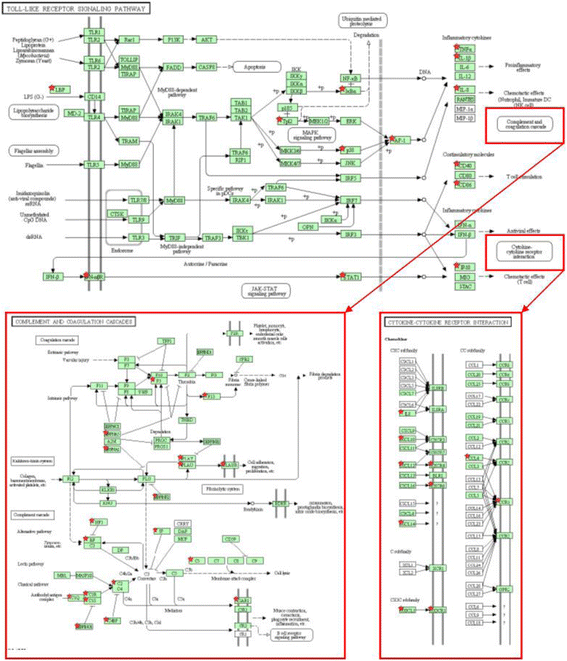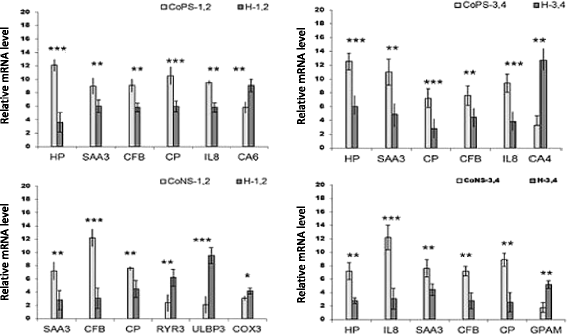Transcriptome profiling of Staphylococci-infected cow mammary gland parenchyma
- PMID: 28587645
- PMCID: PMC5477815
- DOI: 10.1186/s12917-017-1088-2
Transcriptome profiling of Staphylococci-infected cow mammary gland parenchyma
Abstract
Background: Genome-wide gene expression profiling allows for identification of genes involved in the defense response of the host against pathogens. As presented here, transcriptomic analysis and bioinformatics tools were applied in order to identify genes expressed in the mammary gland parenchyma of cows naturally infected with coagulase-positive and coagulase-negative Staphylococci.
Results: In cows infected with coagulase-positive Staphylococci, being in 1st or 2nd lactation, 1700 differentially expressed genes (DEGs) were identified. However, examination of the 3rd or 4th lactations revealed 2200 DEGs. Gene ontology functional classification showed the molecular functions of the DEGs overrepresented the activity of cytokines, chemokines, and their receptors. In cows infected with coagulase-negative Staphylococci, in the 1st or 2nd lactations 418 DEGs, while in the 3rd or 4th lactations, 1200 DEGs were identified that involved in molecular functions such as protein, calcium ion and lipid binding, chemokine activity, and protein homodimerization. Gene network analysis showed DEGs associated with inflammation, cell migration, and immune response to infection, development of cells and tissues, and humoral responses to infections caused by both types of Staphylococci.
Conclusion: A coagulase-positive Staphylococci infection caused a markedly stronger host response than that of coagulase-negative, resulting in vastly increased DEGs. A significant increase in the expression of the FOS, TNF, and genes encoding the major histocompatibility complex proteins (MHC) was observed. It suggests these genes play a key role in the synchronization of the immune response of the cow's parenchyma against mastitis-causing bacteria. Moreover, the following genes that belong to several physiological pathways (KEGG pathways) were selected for further studies as candidate genes of mammary gland immune response for use in Marker Assisted Selection (MAS): chemokine signaling pathway (CCL2, CXCL5, HCK, CCR1), cell adhesion molecules (CAMs) pathway (BOLA-DQA2, BOLA-DQA1, F11R, ITGAL, CD86), antigen processing and presentation pathway (CD8A, PDIA3, LGMN, IFI30, HSPA1A), and NOD-like receptor signaling pathway (TNF, IL8, IL18, NFKBIA).
Keywords: Chronic mastitis; Dairy cows; Gene expression profiling; Transcriptomics; Udder parenchyma; microarray; qPCR.
Figures


Similar articles
-
Expression patterns of β-defensin and cathelicidin genes in parenchyma of bovine mammary gland infected with coagulase-positive or coagulase-negative Staphylococci.BMC Vet Res. 2014 Oct 6;10:246. doi: 10.1186/s12917-014-0246-z. BMC Vet Res. 2014. PMID: 25286984 Free PMC article.
-
Expression of cytokines in dairy cattle mammary gland parenchyma during chronic staphylococcal infection.Vet Res. 2021 Oct 18;52(1):132. doi: 10.1186/s13567-021-01003-y. Vet Res. 2021. PMID: 34663465 Free PMC article.
-
Short communication: Locus-specific interrelations between gene expression and DNA methylation patterns in bovine mammary gland infected by coagulase-positive and coagulase-negative staphylococci.J Dairy Sci. 2020 Nov;103(11):10689-10695. doi: 10.3168/jds.2020-18404. Epub 2020 Sep 18. J Dairy Sci. 2020. PMID: 32952032
-
Coagulase-negative staphylococci as cause of bovine mastitis- not so different from Staphylococcus aureus?Vet Microbiol. 2009 Feb 16;134(1-2):29-36. doi: 10.1016/j.vetmic.2008.09.011. Epub 2008 Sep 11. Vet Microbiol. 2009. PMID: 18977615 Review.
-
Coagulase-negative staphylococci-emerging mastitis pathogens.Vet Microbiol. 2009 Feb 16;134(1-2):3-8. doi: 10.1016/j.vetmic.2008.09.015. Epub 2008 Sep 11. Vet Microbiol. 2009. PMID: 18848410 Review.
Cited by
-
Intramammary Infusion of Micronised Purified Flavonoid Fraction (MPFF) in Mastitis-Diagnosed Dairy Cows Naturally Infected by Staphylococcus spp. in the Late Lactation.Vet Sci. 2023 May 6;10(5):335. doi: 10.3390/vetsci10050335. Vet Sci. 2023. PMID: 37235418 Free PMC article.
-
Whole exome sequencing for identifying rare genetic variants related to idiopathic granulomatous mastitis.Clin Rheumatol. 2025 Apr;44(4):1843-1850. doi: 10.1007/s10067-025-07343-w. Epub 2025 Feb 24. Clin Rheumatol. 2025. PMID: 39992598 Free PMC article.
-
Technological interventions and advances in the diagnosis of intramammary infections in animals with emphasis on bovine population-a review.Vet Q. 2019 Dec;39(1):76-94. doi: 10.1080/01652176.2019.1642546. Vet Q. 2019. PMID: 31288621 Free PMC article. Review.
-
Genome-Wide DNA Methylation and Transcriptome Integration Associates DNA Methylation Changes with Bovine Subclinical Mastitis Caused by Staphylococcus chromogenes.Int J Mol Sci. 2023 Jun 20;24(12):10369. doi: 10.3390/ijms241210369. Int J Mol Sci. 2023. PMID: 37373515 Free PMC article.
-
Potential of immune-related genes as promising biomarkers for premature coronary heart disease through high throughput sequencing and integrated bioinformatics analysis.Front Cardiovasc Med. 2022 Aug 26;9:893502. doi: 10.3389/fcvm.2022.893502. eCollection 2022. Front Cardiovasc Med. 2022. PMID: 36093144 Free PMC article.
References
-
- Petzl W, Zerbe H, Gunther J, Yang W, Seyfert H-M, Nurnberg G, et al. Escherichia coli, but not Staphylococcus aureus triggers an early increased expression of factors contributing to the innate immune defense in the udder of the cow. Vet Res. 2008;39:18. - PubMed
-
- Sender G, Korwin-Kossakowska A, Pawlik A, Galal Abdel Hameed K, Oprządek J. Genetic basis of mastitis resistance in dairy cattle – a review. Ann Anim Sci. 2013;13:663–673. doi: 10.2478/aoas-2013-0043. - DOI
-
- Sordillo LM. Factors affecting mammary gland immunity and mastitis susceptibility. Livest Prod Sci. 2005;98:89–99. doi: 10.1016/j.livprodsci.2005.10.017. - DOI
-
- Oviedo-Boyso J, Valdez-Alarcón JJ, Cajero-Juárez M, Ochoa-Zarzosa A, López-Meza JE, Bravo-Patiño A, et al. Innate immune response of bovine mammary gland to pathogenic bacteria responsible for mastitis. J Inf Secur. 2007;54:399–409. - PubMed
MeSH terms
Substances
LinkOut - more resources
Full Text Sources
Other Literature Sources
Medical
Research Materials
Miscellaneous

